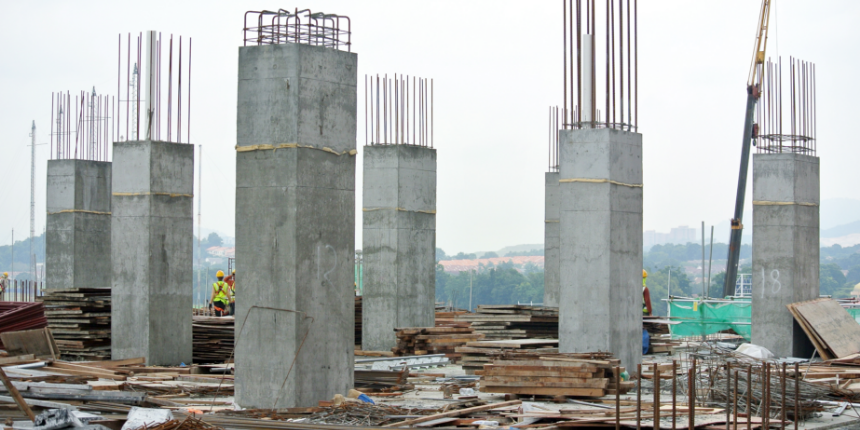In this blog post, we will discuss the columns sizes and essential thumb rules for column layout used in the building construction.
Also Read: What Should be Your Standard Dining Room Dimension
Standard Buiding Column Size

The size of building column is based upon varied factors including the load on the structure, height of the building, material used, grade of concrete, and distance between the columns. Moreover, several types of columns used in the structures in building construction, classified as RCC columns, long columns, short columns, timber columns, spiral columns, tied columns, etc.
| Height of Structure | Different Levels | Size of Column in mm |
| Upto 10 Storeys | 1-10 floors | 700 mm X 700 mm |
| Upto 20 Storeys | 1 – 7 floors | 750 mm X 750 mm |
| 8 – 14 floors | 600 mm X 600 mm | |
| 15-20 floors | 450 mm X 450 mm | |
| Upto 30 Storeys | 1 – 10 floors | 800 mm X 800 mm |
| 11 – 20 floors | 650 mm X 650 mm | |
| 21 – 30 floors | 470 mm X 470 mm |
Standard Column Dimensions

The standard size of the column in building is determined by the load coming on the column, from the beam and slab. In the case of high-rise structures, the column size increases, transferring the load of the structure above to below and finally to the foundation. Other factors like the quantity of concrete, the number of steel bars to be used, spacing between the stirrups are reviewed in the structural design of the column in building.
Column Details for a One Storey (G+0) Building
| Minimum size of column | 9″ X 9″ (225mm X225mm) |
| Main Bars (Main Steel bar dia) | 4 bars of 12mm dia |
| Stirrups for shear reinforcement | 8mm dia bars @ 6″ spacing |
| Grade of concrete | M20 Concrete (1 : 1.5 : 3) |
Column Details for a Two-storey (G+1) Building
| Minimum size of column | 9″ X 12″ (225mm X300mm) |
| Main Bars (Main Steel bar dia) | 6 bars of 12mm dia |
| Stirrups for shear reinforcement | 8mm dia bars @ 6″ spacing |
| Grade of concrete | M20 Concrete (1 : 1.5 : 3) |
Column Details for a Three-storey (G+2) Building
| Minimum size of column | 12″ X 12″ (300mm X300mm) |
| Main Bars (Main Steel bar dia) | 6 bars of 12mm dia |
| Stirrups for shear reinforcement | 8mm dia bars @ 6″ spacing |
| Grade of concrete | M20 Concrete (1 : 1.5 : 3) |
Column details for a Four-storey (G+3) Building
| Minimum size of column | 12″ X 14″ (300mm X350mm) |
| Main Bars (Main Steel bar dia) | 4 bars of 16mm dia+2 bars of 12mm dia |
| Stirrups for shear reinforcement | 10mm dia bars @ 6″ spacing |
| Grade of concrete | M25 Concrete (1 : 1 : 2) |
Thumb Rule Used in Construction
RCC columns are used in the building construction as they are economical and can bear more load easily. The minimum house column size used in construction is 9”x 9” (225mm x 225mm) with four bars of 12mm Fe500 Steel with M20 grade concrete, which is in the ratio of 1: 1.5 : 3 (1 portion of cement and 1.5 portion of sand and 3 parts of coarse aggregate with 0.5 of water).
Also Check: What Should be Your Standard Modular Kitchen Size and Dimension
Factors Affecting Column Size in Building Construction

The size of house column depends upon the load to be supported, type of column, materials, the distance between columns, architectural design, and the structure of construction. Below specified are the major factors that affect the column size in the building construction.
Height of the Structure
With the rise of height in the building, the dead load (static load) and live load (variable load) increase. Hence, we need to increase the strength of the RCC structure to rectify the balance. As mentioned above, column transfer load from beams and slabs to the foundation of the building. Therefore, the column size and reinforcement need to be expanded as the height increases.
Standard Distance of Column for Two-storey House
The centre distance between two columns must be kept similar in all situations of construction. Factors like architectural considerations, height of the structure, and the function of the building, play a significant role in regulating an optimum span between two RCC columns.
If the standard distance between two columns reinforces, the column dimensions increase. The distance between columns and the height of the structure is directly proportional to column size. For a 9” x 9” column size, the maximum distance between two columns in feet is 14 for smaller buildings. While for high-rise buildings, the centre distance between two columns shouldn’t be more than 23 feet.
Alignment of the Columns
A rectangular grid is prepared in a survey of the placement of the columns to avoid errors and unnecessary complications in construction. Further, it reduces the cost of construction as well as the desired time in constructing the building. The columns can preferably be arranged in two different ways:
- In a straight line with the help of a grid.
- The circular manner in circular buildings.
- Avoid the zig-zag arrangement of columns in structural design for the safety of construction.
